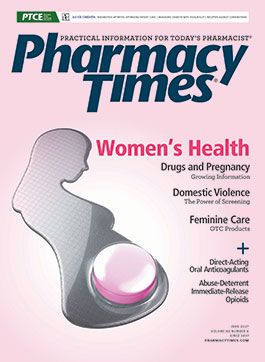Publication
Article
Pharmacy Times
The Dangers of Drug Interactions With DOACs
As direct-acting oral anticoagulants (doacs) have become increasingly popular, instances of drug interactions in patients have begun to appear in the literature.
As direct-acting oral anticoagulants (doacs) have become increasingly popular, instances of drug interactions in patients have begun to appear in the literature. Several of these cases are summarized below.
INTERACTIONS REPORTED WITH RIVAROXABAN
Rivaroxaban is metabolized by CYP3A4 and is a substrate for P-glycoprotein (P-gp). Inhibitors of CYP3A4 and P-gp (eg, clarithromycin, erythromycin, ketoconazole, ritonavir) have been reported to increase the area under the concentration time curve (AUC) of rivaroxaban by 50% to 300%.
Case 1: A patient with HIV was taking etravirine, ritonavir, darunavir, raltegravir, and tenofovir/ emtricitabine.1 Rivaroxaban 10 mg daily was initiated following a total hip replacement. About 24 hours later, the patient developed thigh swelling with anemia and hypotension. His prothrombin time (PT) was prolonged (ie, 24 seconds), and his rivaroxaban plasma concentration 24 hours after the dose was 75 ng/mL (normal: ~10 ng/mL). After treatment and discontinuation of rivaroxaban, prothrombin complex, and packed red blood cells, his PT level returned to normal after 24 hours.
Case 2: Bisoprolol and valsartan were prescribed to a patient with hypertension. He was subsequently prescribed rivaroxaban 20 mg/day and amiodarone for atrial fibrillation.2 Several months later, he developed sudden onset of aphasia, hemiparesis, somnolence, and vomiting because of a cerebral bleed, which resulted in his death. The patient’s prothrombin time also was prolonged to about twice the normal length. Amiodarone is an inhibitor of both CYP3A4 and P-gp and would be expected to increase rivaroxaban plasma concentrations, leading to excessive anticoagulation.
Case 3: A patient taking pantoprazole, prednisone, rituximab, co-trimoxazole, and tiotropium was admitted to the hospital with hemoptysis, epistaxis, headache, and syncope.3 He had started rivaroxaban 20 mg daily 4 months earlier. Three days prior to admission, he self-initiated clarithromycin 500 mg twice daily for signs of an upper respiratory infection. The patient soon after developed intracranial and pulmonary hemorrhages. Clarithromycin and rivaroxaban were discontinued, and the patient fully recovered. Rivaroxaban was restarted without further problems. Clarithromycin has been noted to increase rivaroxaban plasma concentrations due to its CYP3A4 and P-gp inhibition.
Case 4: A patient with a history of epilepsy being treated with carbamazepine 900 mg/day was placed on rivaroxaban 20 mg/day for venous thrombosis.4 Four months later, the patient developed a recurrent venous thrombosis. His anti-Xa activity was low, indicating lack of adequate rivaroxaban efficacy. Carbamazepine is an inducer of CYP3A4 and P-gp and likely was responsible for the reduced plasma concentrations of rivaroxaban and the lack of DOAC efficacy seen in this patient.
INTERACTIONS REPORTED WITH DABIGATRAN
Dabigatran etexilate is a prodrug that is hydrolized to an active moiety (dabigatran) by carboxylesterases; it is a substrate for P-gp. Known P-gp inhibitors (eg, amiodarone, ketoconazole, quinidine) have been shown to increase the AUC of dabigatran by over 100%. The effect of cobicistat, a P-gp inhibitor, on dabigatran pharmacokinetics has been described.5 Compared with dabigatran administered alone, the simultaneous administration of cobicistat (150 mg/ day for 14 days) increases the mean AUC of dabigatran by 127%. Further, when dabigatran is administered 2 hours before a dose of cobicistat, the mean dabigatran AUC rises 110%. These increases in dabigatran plasma concentration are accompanied by an increase in its anticoagulant effect.
Case: Two patients were reported to have reduced dabigatran efficacy, or plasma concentration, when coadministered phenytoin, the P-gp inducer.6,7 In one of the cases, the patient developed a left atrial thrombus during concurrent phenytoin and dabigatran therapy.
END NOTE
These cases illustrate the need to be alert to the co-prescribing of drugs that can inhibit or induce the elimination of DOACs. Although these anticoagulants are generally considered less prone to drug interactions than warfarin, the response to them can be significantly altered by concurrently administered drugs. Increased DOAC concentrations can result in bleeding episodes, whereas reduced DOAC efficacy with a potential for thrombus formation is possible during drug-induced induction of the anticoagulant’s elimination.
Drs. Horn and Hansten are both professors of pharmacy at the University of Washington School of Pharmacy. For an electronic version of this article, including references, visit hanstenandhorn.com.







